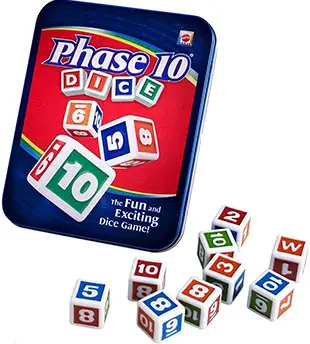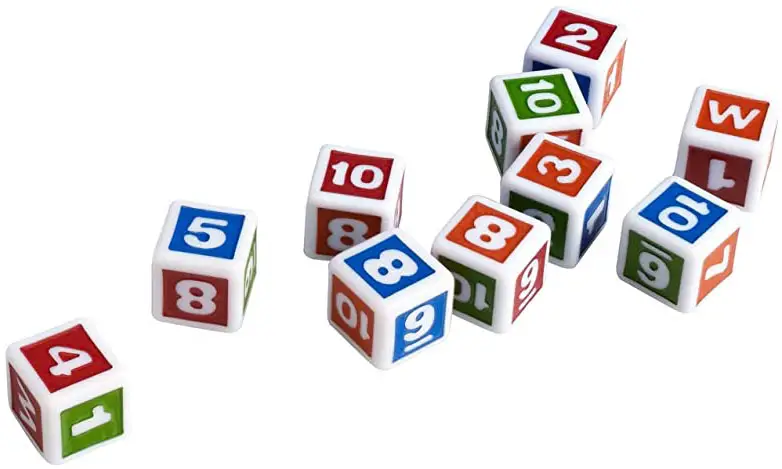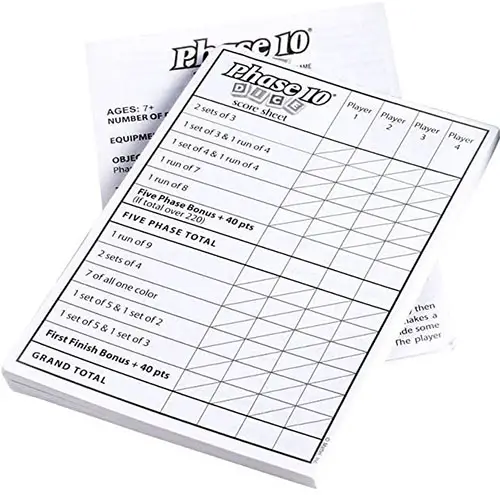

Components
- 10 special PHASE 10 DICE
- one scorepad
- Instructions
Object of the Game
Win the game by being the first to get through the 10 Phases with the highest overall score.
The Phase 10 Dice
Six of the dice contain all the high numbers. Each of the dice are numbered 5,6,7,8,9,10 in the various four colors. The other four dice contain all the low numbers and the Wild (W) faces. Each of these die are numbered with 1,2,3,4 and W. The W is in the four various colors.

Game Play
To see who plays first, each player rolls one of the dice numbered 5 to 10. The player with the highest roll plays first, and so on, down to the player with the lowest roll, who plays last.
Each player takes a separate column on the scorepad. The player with the first turn uses the left-most column, the next player uses the next column, and so on, so that turns pass in order from one player's column to the next.
Each player's name is written at the top of the player's column. When each player has had a turn, the first player begins the next turn, and so on.
In a turn, the player starts by rolling all ten dice. The player may then set aside any dice the player wishes to keep. The player makes a second roll with the remaining dice.
The player may set aside some of these dice, adding them to those already set aside. The player may also take back some of the dice previously set aside. Then the player may make a third and final roll with any dice the player wishes to roll. The player then takes the score, if any, and ends the turn.

Scorepad Terms
Sets, Runs, and All One Color are explained as follows.
Sets: A set is made by several dice with all the same number. For example, three 10's make a set of three. One or more Wild (W) dice may be used in place of natural numbers. For example, 10, W, W makes a set of three 10's.
Runs: A run is made by several dice with all consecutive numbers. For example, 7,8,9,10 makes a run of four. One or more Wild (W) dice may be used in place of natural numbers. For example, 6, W, W, 9 makes a run of four.
All One Color: The dice needed must all be the same color. A Wild (W) of a different color may not be used in completing this score. For example, 2, 4, W, 5, 8, 9, 10 all orange make 7 all one color.
The Phases
In a player's scoring column are ten scoring spaces. Each one of these is a Phase. For example, the first one (Phase 1) is labeled "2 sets of 3", meaning that the player must, in the turn, end up with three of one number and three of another number, or two sets of three of the same number.
Throughout play the player must always do the ten Phases in order, starting with Phase 1 and working up through Phase 10. If a player fails to make a Phase in a turn (which will almost always happen to all players at some point), then the player ends the turn without taking a score. The player will have to try and complete that Phase again next turn.
Scoring
At the end of the turn, the player scores points for the Phase the player is working on, only if the player makes that Phase. The score is the total of all the dice used to make that Phase.
Dice not needed for the Phase are not scored. Also any Wilds (W's) used in the Phase score zero points each. For example, the player is in Phase 1 and ends up with 8, 8, 8 and 10, W, W. The player's score is 8+8+8+10, or 34. The player enters 34 in the space for "2 sets of 3".
STRATEGY HINT: If a player completes a Phase in one or two rolls, the player may want to keep rolling the rest of the turn, to try to replace any Wilds (W's) in the Phase with natural numbers, since natural numbers score their value instead of zero.
Note that as each Phase is completed, the score is totaled, so that the player always knows his/her total score in the game, as of that particular Phase.
Five Phase Bonus: After Phase 5, the game is half over. If the player's total at this point is over 220 (221 or more), then the player is awarded a bonus of 40 points, which is then added to the score.
First Finish Bonus: The first player to finish the game gets to add 40 points to his/her score. Other players may qualify for this 40 point bonus too, but only if they are already in Phase 10, successfully complete this Phase, and also did not start the game ahead of the Player who was first to finish Phase 10.
End of the Game
The first player to complete Phase 10 causes the end of normal game play. At this point, each of the remaining players gets one last try at completing all their remaining Phases.
For example, player B has just completed Phase 10, while player A is still on Phase 7. Now, player A gets a normal turn of three rolls to complete Phase 7. If unsuccessful, player A is finished, and player A's current total score becomes player A's final score.
If successful, however, player A adds the Phase 7 score to his/her score, and gets another turn, to try and make Phase 8, and so on, until player A finally fails to make the next Phase, or finishes Phase 10.
When each player's score is final, the player with the highest Grand Total is the winner.
Solitaire Play: You can play solitaire, and see how high a score you can get. All rules remain the same except you must keep track of each time you fail to make a Phase.
At the end of the game, you must subtract 5 points off of your final score for each failure to make the Phase. Also, to get your 40 point First Finish Bonus, you must make Phase 10 on your first try.
Highest Possible Score: The highest possible score is 649. Please write us at the address below if you make a score over 600 (requires the signature of at least one witness, other than player).
Continue Reading


